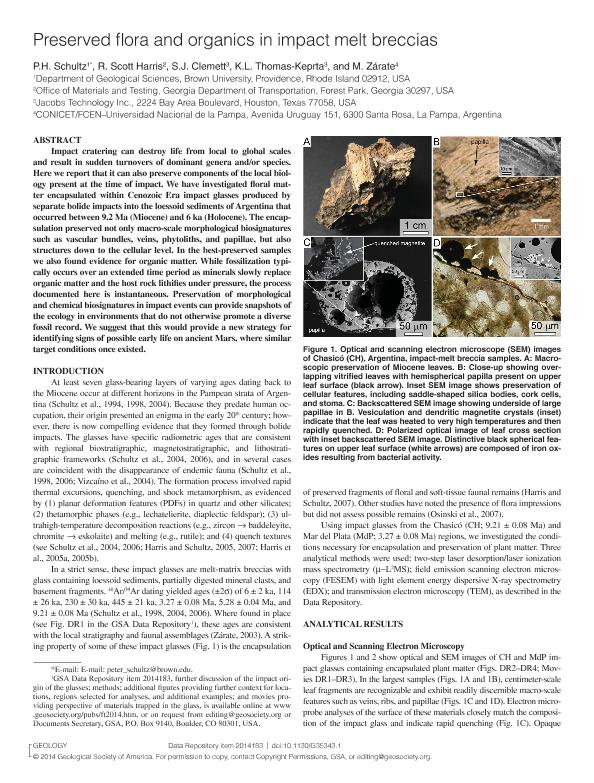Artículo
Preserved flora and organics in impact melt breccias
Fecha de publicación:
06/2014
Editorial:
Geological Society of America
Revista:
Geology
ISSN:
0091-7613
e-ISSN:
1943-2682
Idioma:
Inglés
Tipo de recurso:
Artículo publicado
Clasificación temática:
Resumen
Impact cratering can destroy life from local to global scales and result in sudden turnovers of dominant genera and/or species. Here we report that it can also preserve components of the local biology present at the time of impact. We have investigated floral matter encapsulated within Cenozoic Era impact glasses produced by separate bolide impacts into the loessoid sediments of Argentina that occurred between 9.2 Ma (Miocene) and 6 ka (Holocene). The encapsulation preserved not only macro-scale morphological biosignatures such as vascular bundles, veins, phytoliths, and papillae, but also structures down to the cellular level. In the best-preserved samples we also found evidence for organic matter. While fossilization typically occurs over an extended time period as minerals slowly replace organic matter and the host rock lithifies under pressure, the process documented here is instantaneous. Preservation of morphological and chemical biosignatures in impact events can provide snapshots of the ecology in environments that do not otherwise promote a diverse fossil record. We suggest that this would provide a new strategy for identifying signs of possible early life on ancient Mars, where similar target conditions once existed.
Palabras clave:
Impact Glasses
,
Organic Remains
,
Pampean Loess
,
Argentina
Archivos asociados
Licencia
Identificadores
Colecciones
Articulos(INCITAP)
Articulos de INST.D/CS D/L/TIERRA Y AMBIENTALES D/L/PAMPA
Articulos de INST.D/CS D/L/TIERRA Y AMBIENTALES D/L/PAMPA
Citación
Schultz, P. H.; Harris, R. Scott; Clemett, S. J. ; Thomas Keprta, K. L. ; Zárate, Marcelo Arístides; Preserved flora and organics in impact melt breccias; Geological Society of America; Geology; 42; 6; 6-2014; 515-518
Compartir
Altmétricas




